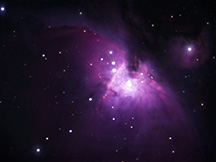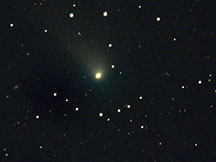
I photographed Comet C/2015 V2 other wise known has Comet V2 Johnson. I took the five minute exposure photos on April, 18th at approximately 22:02. I had initally tried to capture NGC 2068 but it was not visible in the sky. On the night of, the sky was clear of cloud interference and the moon was not present. I used the 12" Meade telescope and the ST-2K camera to capture two images with exposure of 300 seconds. There was no frost on the lens and the chip temperature was -20 degrees celsius. The comet was located at an altitude of 31 degrees in the North-East. Because of the location of the comet there was very little light pollution from Santa Cruz.
I adjusted each photo in CCDOps. I used DK5-20 for dark subtraction followed by fdec31-3 for flat fielding. I used the single shot color utility to process the image with the sRGB+gamma method. Finally, I saved the image as a TIFF into the a8spr17 folder. I took both the photos into Registax to stack the two images and get the best combined result. I left the alignment method on default, the alignbox size at 128, and set the lowest quality to zero. Finally, I moved the stacked version into Photoshop in an attempt to pretty up the image. I used Camera Raw Filter, as suggested by one of my classmates, to reduce exposure and increase contrast. I noticed a lot of unnatural green in the image so I used hue/saturation to reduce those colors significantly. I balanced out the curves to darken the image further and unsharp mask to sharpen the stars and comet which made them more prominent. I then used the astronomy actions to make the stars smaller and reduce space noise. The image remained fairly gritty so I used despeckle in an attempt to reduce that issue further. Finally, I resized and saved the image to make the various final copies we needed. The final product could certainly use more work, but the result is a significant improvement over the original image.
|

Nathan Riera, Jellyfish Nebula (IC443), 12” Meade LX200, ST2000XCM, 4x5min Mar. 7, 2017 21:45-22:05 PST, Cabrillo College Observatory Dome, No moon visible, Crystal clear sky, Object was high in the sky, CCDOPS: Dark Subtract -25C, Flat field, Color Process sRGB+gamma, Registax: Stack 4 frames, Photoshop: Curves RGB (darken background, brighten nebula and stars), Hue/Saturation (reduced saturation of green to remove green pixels), Hue/Saturation (reduced saturation of red to remove red pixels), Contrast enhancement, Deep space noise reduction x2, Saturation +15, Resized for gallery
|
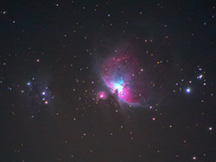
Benno Kolland. NGC 1977-Running Man Nebula and M42-Orion Nebula in Orion
Imaged from my house in Westside Santa Cruz, February 24, 2017 7:40 PM
Rebel SL1 with 55-250mm zoom at 250mm and F/5.6
24 images at 15s each, ISO 1600
Skies were clear with a waning crescent moon well below the horizon, though there was minor light pollution from city lighting. The camera was mounted to a Celestron 8” scope which was polar aligned, and the camera was remote controlled with a Pixel wireless controller for continuous shooting.
Several frames were manually selected and removed from blurred/trailed stars from tracking errors. Files were converted from CR2 RAW to maximum quality JPEG and input to Registax. Images were aligned in Registax with multiple alignpoints on bright stars. Light sharpening and standard Registax exporting was applied and the file was exported to Photoshop CC. Photoshop processing consisted of cropping, curve adjustments to bring out nebula detail without clipping central star highlights, minor sharpening and clarity increases, slight noise reduction, and vibrance increases for color detail.
|
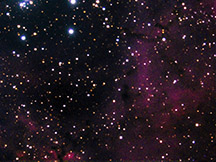
Mallory Moore Spring 2017 Astro 8A Cabrillo College
Photo taken on February 28, 2017 at 8:50pm telescope used: Mead 12' Domescope and photo taken with ST200 XCM camera. Sky conditions were very clear with no fog, clouds, and no moon. Altitude +55 4'. Chip temperature -25.
3 images of 5 minute exposure each were taken into CCDOPS5, dark subtracted, single-shot color processed using SRGB+gamma transfer function, and saved as a tif file. Then stacked the 3 images in Registax. In photoshop, used the lasso function to copy and paste different parts of the photo to cover up the darkened corners where the camera lens had frost on it. Used space noise reduction, reduced blacks, raised whites and saturation, sharpen, adjusted the exposure and contrast. Used the Curves tool to control color and tonal adjustments.
|
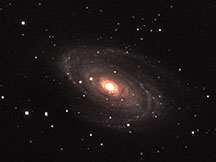
Mason Gutierrez. Messier 81 - Bode's Galaxy. Astronomy 8A Spring 2017.
Taken from the Cabrillo College Observatory on May 2, 2017, at 9:45 P.M.
Telescope used: Mead LX 200 12" Dome Scope. Camera used: ST2000 XCM.
Sky conditions were clear, with the moon in first quarter. The moon was relatively highly visible in the sky, emitting a lot of light. Air conditions were dry, and temperatures were around 54 degrees outside.
3 images taken at 5 minutes each.
CCDops: Dark subtract of -20C, flat field, single shot color.
Registax: Used to stack the 3 images on top of one-another.
Photoshop: Adjusted the curves in order to reduce granulation on the photo, used a stamp in order to delete hot pixels, then used the camera raw filter to adjust the colors of the photo in order to make the galaxy look more natural; adjusted the blues, greens, yellows, and oranges, in order to make the spiral arms more noticeable, as well as make the center pop (subtly). Used a tool to make the stars smaller, as well as increased the vibrancy of the stars and sharpened them to make them look cleaner.
|





